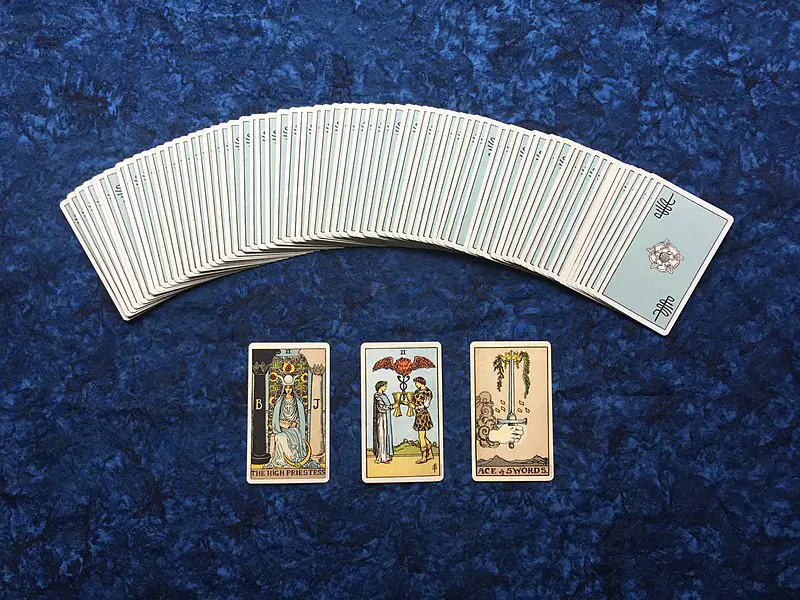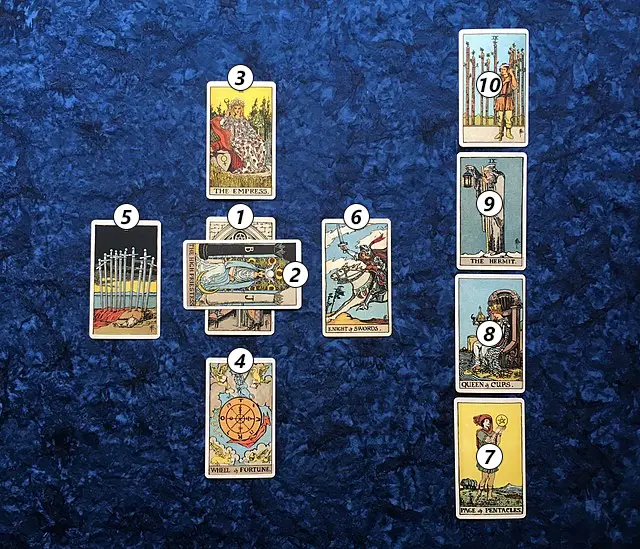
If you're reading this, you're probably at the beginning of your Tarot journey. Learning Tarot can be a daunting task for beginner readers, whether you're interested in reading Tarot professionally or just want to make divination a part of your everyday life. In this guide, we'll break down the absolute essentials that all Tarot readers need to know, including a brief history of Tarot, the structure of a Tarot deck, basic spreads, and resources for enriching your practice.
A Quick History of Tarot
We always hear about Tarot cards in the context of fortune telling or the occult, but their origins are less mystical than you might think.
The Game of Tarot
Tarot first appeared as a card game in early 15th century Italy.
These Tarot games use a standard playing card deck with two additions:
- A fifth suit of 21 cards called “triumphs”
- A special card called The Fool that was similar to a Joker
The suits of a Tarot deck—wands, cups, pentacles, and swords—are Italian equivalents of clubs, hearts, diamonds, and spades.
Tarot's Occult Debut
Tarot was first used for card-based divination, or cartomancy, in 18th century France. Its pioneers were Antoine Court de Gébelin, a famous protestant pastor, and Jean-Baptiste Alliette, the world's first professional Tarot reader.
Court de Gébelin was was fascinated by ancient civilizations. He believed ancient Egyptian priests created the Tarot, and that it made its way to France as a secret of the Roman popes. Even without historical evidence to support these claims, they were published in Court de Gébelin's Le Monde primitif and captured the imaginations of many occultists.
Alliette, better known by the pseudonym Etteilla, published the first known instruction book for Tarot cartomancy four years later.
Now that we know a bit about where Tarot came from, let's talk about the cards themselves.
Tarot Card Decks and Meanings
There are thousands of Tarot decks out there, but they all share some common features.
The Structure of a Tarot Deck
A standard Tarot divination deck contains seventy eight Tarot cards. There are two groups of Tarot cards called the Major and Minor Arcana.
The Major Arcana
Major Arcana cards are the biggest difference between a Tarot deck and the playing cards we're familiar with. They are a suit of 22 cards, each labeled with a Roman numeral from 0 (The Fool) to XXI (The World).
These Tarot cards deal with big ideas like fate, archetypes, and overarching themes of a person's life.
The Minor Arcana
The Minor Arcana contains fifty-six Tarot cards divided into four suits:
- Wands: Passion, motivation, and labor
- Cups: Emotions, intuition, and inspiration
- Pentacles: Possessions, careers, and exchange
- Swords: Ideas, decisions, and power
Each suits contains fourteen cards, including ten numbered cards (A–10) and four court cards (Page, Knight, Queen, and King).
A suit's numbered cards reflect day-to-day activities and mundane events.
Court card interpretations vary more. Sometimes these cards represent literal people in a situation. Others times, they tell us about ways of life, social positions, and personality traits.
Tarot Card Meanings
Learning card meanings can be one of the most intimidating parts of the process for beginner readers. There are thousands of Tarot books on the market and it's hard to decide which resources are credible.
The good (and frustrating) news is that nobody is an authority on Tarot. In fact, Tarot's centuries of diverse history make it impossible to pin down one absolute interpretation for any Tarot card.
Here's my advice as a longtime Tarot reader:
- There is no correct interpretation of any Tarot card, only an interpretation that's right for your practice.
- Your interpretation of a Tarot card will ultimately be a combination of your experience, knowledge, and intuition.
- Exposing yourself to many perspectives will give you a rich relationship with Tarot.
If you're looking for a place to start, give Biddy Tarot a visit. They're a Tarot education website with a ton of free resources, including both flashcard-friendly summaries and in-depth essays on each Tarot card.
You can also check out our Tarot story exercise for a way to make your learning process creative!
The Anatomy of a Tarot Reading
Tarot readings come in many forms.
You can read Tarot for yourself, for another person, and even for multiple people at once. Some people prefer to read Tarot in face-to-face, while others use digital mediums like E-Mail or live streams. You can even incorporate practices like pendulum divination, automatic writing, and intuitive reading.
Again, it's all about what works for you and your practice.
No matter the style of reading, they all have two basic components:
- A Querent, a person (or group of people) seeking guidance
- A Tarot reader, a person who offers insight and guidance through card interpretation
When you read Tarot cards for yourself, you are both the reader and querent. Reading for yourself is fine, but don't underestimate the value of an outside perspective.
Tarot Card Spreads
In a traditional reading, a Tarot reader will arrange Tarot cards in patterns called Tarot spreads.
A card's position in a Tarot spread gives us context for the card's meaning. Some positions might represent a period of time, a person's fears, or astrological concepts. Like Tarot cards, positions in a spread may be interpreted differently from reader to reader.
Here are two of the most iconic Tarot spreads:
Past, Present, and Future
Also known as a three-card spread or three-card pull, this is the first spread that many readers learn. We deal three cards face-up from left to right, as pictured below.

From left to right, these cards reflect a person's past, present, and future.
These same positions can be interpreted many other ways. Here are some examples:
- Mind, Body, and Spirit
- No, Maybe, Yes
- Morning, Afternoon, Evening
- Goals, Obstacles, Current Outcome
- What to Welcome, What to Accept, What to Let Go
Celtic Cross
The Celtic Cross is one of the oldest and best-known spreads in Tarot. Some believe this spread's history has infused it with great spiritual power, and that Tarot readers tap into this power when they use it.
This spread consists of ten cards, as pictured below. Six cards are arranged in a cross, usually beginning with cards 1 and 2. The other four, called the staff, are dealt in a vertical line from bottom to top.

There are many, many interpretations of this spread's positions. Here's one to start with:
- Current Situation
- Obstacle or Challenge
- Recurring Thoughts
- Distant Past
- Recent Past
- Near Future
- Fears
- Environmental Influences
- Hopes
- Current Outcome
Choosing Your First Tarot Deck
Like most of what we've covered here, choosing your first Tarot deck is what works for you.
Whether you're guided by divination or personal taste, here are some features to consider.
Standard vs. Nontraditional Decks
As we've covered, a standard Tarot deck has seventy-eight Tarot cards. Most decks stick to this formula, but you can also buy a nontraditional deck. A nontraditional deck has more, less, or different cards than a standard deck. Many add cards to the Major Arcana or specify unique interpretations for existing cards.
Both standard and nontraditional decks have unique advantages.
The Benefits of a Nontraditional Deck
- Provides new perspectives on a longstanding tradition
- Can diversify the Tarot by including other spiritual practices
- May expand the Tarot to new subjects or focus it on specific areas of interest
The Benefits of a Standard Deck
- There are countless learning resources available for standard decks
- The knowledge you build will apply to any other standard deck you use
- Standard decks are available in many shapes, sizes, and price ranges
In general, standard decks are more approachable for a Tarot beginner, but don't hesitate to buy a variant that speaks to you.
Choosing the Right Size
Tarot cards vary in size, and there are benefits and drawbacks to each option.
Large/Jumbo Decks
- Pros: Visual impact, lots of space for artwork, great on large tables
- Cons: Cramped on small tables, cumbersome to shuffle, more expensive
Small/Travel Decks
- Pros: Portability, big spreads in tiny spaces, easy to hide, less expensive
- Cons: Small artwork, easy to lose, novelty/toy vibe, can be difficult to shuffle
Medium Decks
- Pros: Easy to shuffle, enough room for artwork, space for larger spreads
- Cons: Don't excel at anything in particular
A medium-size deck is the most popular and versatile starting option, but let your needs guide you.
Be Frugal
Buying a big, fancy collector's box with breathtaking artwork is tempting, but not always the best option. You don't know whether Tarot will be a lifelong interest or fleeting whim, and there's plenty of time to expand your collection.
Affordable decks are easier to replace, less expensive to lose or damage, and easier to travel with.
The Rider-Waite Deck
Rider-Waite is a beloved Tarot starter deck for good reason. It's affordable, versatile, available in many sizes, and contains rich symbolism. Its in-box guide is also one of the more universal and beginner-friendly Tarot books on the market. If you're looking for a place to start, it's a solid bet.
Tarot is a complex and enriching journey of spirituality, curiosity, and self-development. No matter where it leads you, we hope that this information is a guidepost on your path.
Have a burning question? See something we missed? Let us know in the comments!